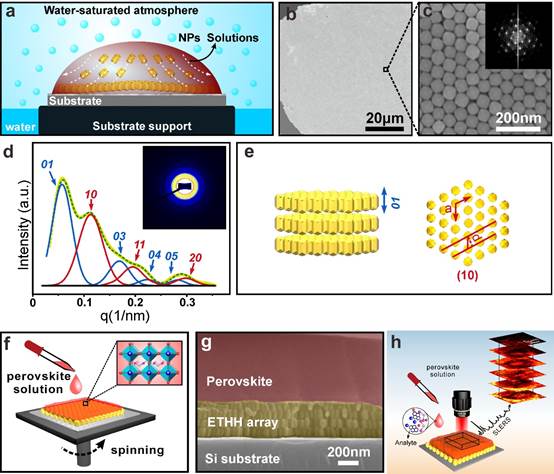
News and Events
Science Highlights
Home /
| Superficial-Layer-Enhanced Raman Scattering (SLERS) for Depth Detection of Noncontact Molecules |
|
From:
PublishDate:2020-07-31
Hits:
|
Prof. Wang Tie’ group from the Institute of Chemistry of Chinese Academy of Sciences developed a superficial-layer-enhanced Raman scattering (SLERS) technique for detecting analytes that are noninteractive with Raman-active substrates, by covering elongated tetrahexahedral gold nanoparticle (ETHH Au NP) arrays with a superficial perovskite film. Synchrotron-based small-angle X-ray scattering (SAXS) from 1W2A station of Beijing Synchrotron Radiation Facility was performed to characterize the structure of the ETHH NP arrays. These ETHH NP arrays provide uniform and high-density SERS hotspot platforms, and the perovskite film as a dielectric media retards attenuation of the electromagnetic evanescent wave. The information presented here will be useful for both understanding the mechanism of SLERS, and for the widespread application of Raman sensors. 
Fig. a) Schematic diagram of the formation of a large‐scale ETHH NP arrays. b) Low‐ and c) high‐magnification SEM image of ETHH NP arrays. Inset of (c): FFT pattern of vertical ETHH NP arrays in a hexagonal lattice. d) The integrated data from the synchrotron‐based SAXS pattern (inset) shown that the ETHH NP arrays combined lamellar (indicated in blue) and hexagonal structures (indicated in red), as illustrated by (e). f) Schematic illustration of ETHH NP arrays coated by perovskite. g) Cross‐sectional SEM images and h) energy‐dispersive spectroscopy mapping demonstrating the perovskite film on ETHH NP arrays. Article: Xuezhi Qiao, Zhenjie Xue, Lu Liu, Keyan Liu, and Tie Wang*. Superficial-Layer-Enhanced Raman Scattering (SLERS) for Depth Detection of Noncontact Molecules. Adv. Mater. 2019, 31, 1804275. |
|
|
Copyright © 2011 - 2012 Beijing Synchrotron Radiation Facility


